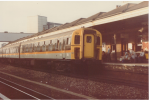Moderators, I put this in this sub forum, as thought be too old information for traction section, so feel free to move if necessary.
I have just watched, a You Tube video of Southern Electric Units in the 1980’s, , and though know some of the names, like 2 HAP, i do not know, what it stands for, or what they look like, so it would be good if could have pics and information on the Southern Electric units, so when watch a video etc, I know what I’m looking at. I’m 49 so remember them a bit, but never really got my head around them all.
I liked the Jaffa Cake liveried units, as they were on fast services, but have no idea,what number or designation they were, so I’m really just interested in slam door units and not the modern stuff, as know pretty much all the modern stuff, hope people can help.
I have just watched, a You Tube video of Southern Electric Units in the 1980’s, , and though know some of the names, like 2 HAP, i do not know, what it stands for, or what they look like, so it would be good if could have pics and information on the Southern Electric units, so when watch a video etc, I know what I’m looking at. I’m 49 so remember them a bit, but never really got my head around them all.
I liked the Jaffa Cake liveried units, as they were on fast services, but have no idea,what number or designation they were, so I’m really just interested in slam door units and not the modern stuff, as know pretty much all the modern stuff, hope people can help.


